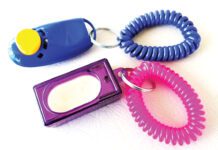Counter-conditioning involves changing your dog’s association with a scary or arousing stimulus from negative to positive. Desensitization is starting with a very low-level intensity of aversive stimulus until the dog habituates to (or changes his association with) the aversive, and then gradually increasing the strength until the dog is comfortable with the stimulus at full intensity. The easiest way to give most dogs a positive association and to help them become comfortable with a stimulus is with very high-value, really yummy treats. I like to use chicken – canned, baked, or boiled; most dogs love chicken. Here’s how the CC&D process works.
1. Determine the distance at which your dog can be in the presence of another dog and be alert or wary but not extremely fearful or aroused. This is called the threshold distance.
2. With you holding your dog on leash, have a helper present a neutral dog at threshold distance X. (Alternatively, station yourself and your dog at a location where people pass by with their dogs on leash at threshold distance X.) The instant your dog sees the other dog, start feeding bits of chicken, non-stop.
3. After several seconds, have the helper remove the dog, and stop feeding chicken to your dog.
4. Keep repeating steps 1-3 until the presentation of the dog at that distance consistently causes your dog to look at you with a happy smile and a “Yay! Where’s my chicken?” expression. This is a conditioned emotional response (CER) – your dog’s association with the other dog at threshold distance X is now positive instead of negative.
5. Now you need to increase the intensity of the other-dog stimulus. You can do that by decreasing distance by several inches; by increasing the amount of time the neutral dog stays in sight; by increasing movement of the other dog at distance X; by increasing the number of dogs (two or three dogs, instead of one); or increasing the visual “threat” (a large dog instead of a small one, or allowing the neutral dog to make brief eye contact). I’d suggest decreasing distance first in small increments by moving the reactive dog closer to the location where the neutral dog will appear, achieving the CER at each new distance.
6. Then return to distance X and add intensity of the neutral dog, gradually decreasing distance and attaining CERs along the way, until your dog is delighted to have the neutral dog reasonably close.
7. Now, back to distance X, increase intensity again, by having your helper move more quickly with the neutral dog, have the dog do more vigorous behaviors – roll over, catch a ball, etc.
8. Repeat until you have the CER, then gradually increase the length of time you have your dog in the presence of the increased-intensity neutral dog, until he’s happy (but not aroused) to have it present continuously.
9. Begin decreasing distance in small increments, moving the dog closer to the stimulus, obtaining the CER consistently at each new distance.
10. When your dog is happy to have the higher intensity neutral dog stimulus close to him, you’re ready for the final phase. Return to distance X and obtain your CER there, with a full intensity neutral dog – zigzagging toward him, then approaching head-on. Gradually decrease distance until your dog is happy to be in the presence of other dog, regardless of that dog’s behavior. He now thinks the other dog is a very good thing, as a reliable predictor of very yummy treats.
The more intense the reactive dog’s response, the more challenging the behavior is to modify. A fear response is more challenging to modify than an excitement response. True anxieties and phobias generally require a greater commitment to a longer term and more in-depth modification program than less intense fear-based behaviors (see “How an Intense Behavior Modification Program Saved One Puppy’s Life”).





